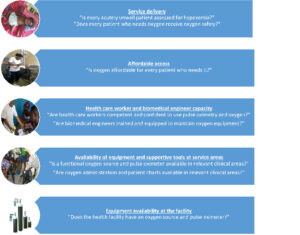05 Aug Call to action to fill pneumonia data gaps
Mangipudi and colleagues1 recently highlighted the paucity of data on oxygen availability in low- and middle-income countries (LMICs). Despite being classified an essential medicine by the World Health Organization, availability of oxygen is not currently a standard health system indicator, unlike vaccination and malaria bed net coverage for example. Where oxygen is included in facility surveys, such as the Service Provision Assessment (SPA) and Service Availability and Readiness Assessment (SARA), analytic methods use a binary yes/no indicator for facilities as a whole. This simplistic approach grossly overestimates actual oxygen access and ignores deep complexities, such as access within relevant clinical service areas, equipment failures, and under-recognition of patients who warrant oxygen therapy, as a recent study in Nigeria shows.
These data gaps are a major limitation in the fight to reduce deaths from hypoxemia by hindering investment decisions and accountability mechanisms, with newborns and children under five with pneumonia among the most affected. The COVID-19 pandemic has exposed this deficiency, leading many hospitals, governments, and global health institutions scrambling to conduct needs assessments and rapidly increase oxygen capacity.
Since 2018, the Every Breath Counts Coalition has been working to improve the way oxygen and key pneumonia-related indicators are collected and reported, recommending specific indicators that should be adopted at health facilities, national governments, and global health agencies. This ongoing work builds on efforts in LMICs to reach consensus on pragmatic and useful indicators. There is a move away from binary equipment metrics toward more meaningful and patient-centered metrics (Figure 1). These include measuring (1) the proportion of acutely unwell patients who are assessed for hypoxemia using pulse oximetry and (2) the proportion of hypoxemic patients for whom oxygen is given. These metrics can, and should, be integrated into national health information and reporting systems.
Facility surveys, such as SPA and SARA, should also be improved to provide more accurate assessments of oxygen access. As a coalition we recommend three improvements: (1) record availability of oxygen at service areas, including pediatric, neonatal, maternity, and surgical areas; (2) gather information on complementary equipment necessary for providing safe, high-quality oxygen services, including pulse oximeters, concentrators, cylinders, and delivery interfaces; and (3) measure functionality of oxygen equipment to test if oxygen sources are in fact delivering medical grade oxygen. Crucial to this approach is ensuring local leadership and experience is at the forefront, so indicators are realistic and meaningful within different contexts and provide actionable information to facility administrators and health policymakers.
The COVID-19 pandemic has shone a bright light on the need for scaled-up and sustainable oxygen in LMICs. However, it is crucial that with improvements to oxygen supply systems, we also see coordinated efforts to eliminate these associated data gaps, and ensure equitable oxygen access during COVID-19 and beyond.

August 2020


